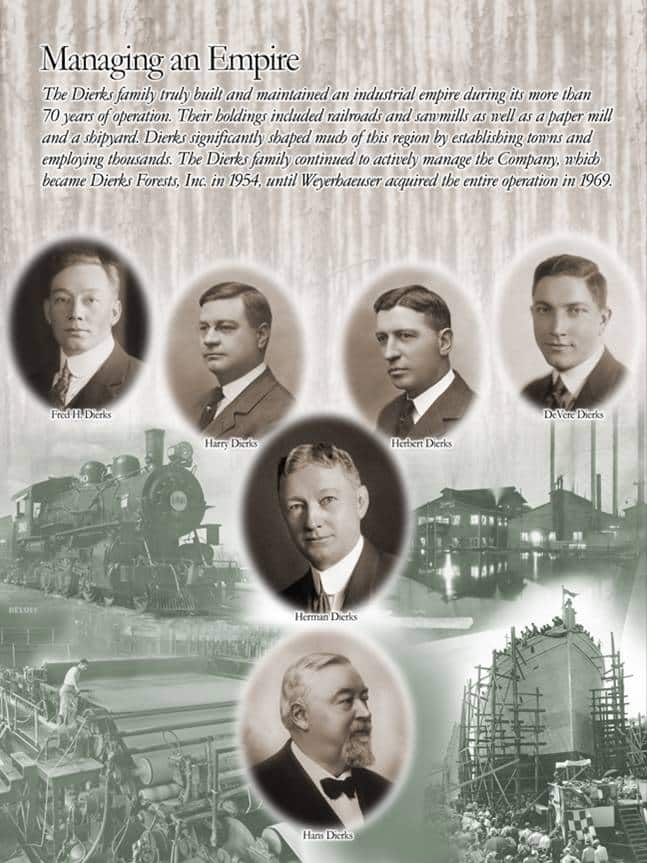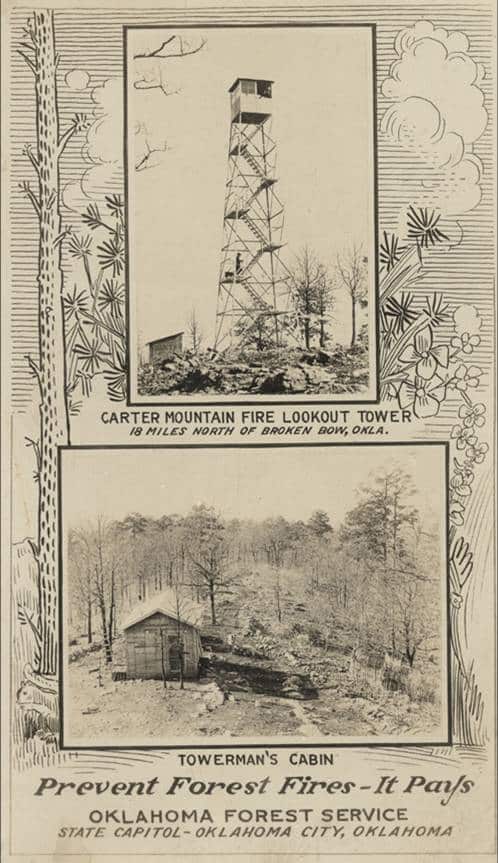History of the Oklahoma State Forestry Division
Activities of the past strongly influence the forests of today, and the things we do today will influence these same forests for generations.
Oklahoma’s state forestry agency has managed and protected Oklahoma’s diverse forest resources since 1925, enjoying a rich and colorful past. The Oklahoma Forest Commission was created by Oklahoma’s 10th Legislature on April 6, 1925 and began official operations on July 1st of that year. The agency was created primarily in response to the deteriorating condition of the state’s forests, attributed primarily to excessive timber harvesting without forest regeneration, and to uncontrolled wildfires that damaged or destroyed property, threatened lives and discouraged any interest in making investments or improvements in these lands.
Over the years, our programs of assistance to the citizens of Oklahoma have responded to changing needs and resource conditions across the state. A decade-by-decade thumbnail sketch of program highlights is provided.
An overview of the early years of forestry in Oklahoma is also provided. Using photographs from the collection at the Forest Heritage Center, this overview portrays the early development of Oklahoma’s timber industry, with the coming of Dierks Forests in the early 1900s, and focuses on the people who laid the groundwork for those who followed.
Pre-Statehood – 1920
The Caddo people occupied these lands several thousand years ago. The Choctaws were forced out of eastern US and settled here in 1830. These early peoples had little impact on the region’s forests, although they did clear some lands for agriculture and used fire. White settlement started to show up in the late 1800s.
Some inkling of what was going on by this time is reflected in a report issued by the US Geological Survey in 1900 – The Woodlands of Indian Territory. This report was based upon extensive fieldwork from 1895 to 1898, about the time Oklahoma’s timber industry was in its infancy. This report described the vegetation in each township, and noted the location of many small “peckerwood” sawmills already located here, and starting to tap our vast timber resources.
The Dierks empire began in this country in the 1850s. Peter Henry Dierks immigrated to the US in 1852, and became a farmer in Iowa. His sons John (in 1879) and Hans (in 1881) left farming for the lumber business. They established a series of lumberyards in southeast Iowa, then followed the rail lines into Nebraska and in 1886 followed the new railroad into Broken Bow, Nebraska. Then they began constructing railroads and eventually decided to purchase tracts of timber to supply the material for their expanding retail lumber business.
According to Don Dierks, Jr., there were several factors that precipitated their move to Oklahoma and Arkansas, starting in the late 1890s. By 1896, Hans had moved to Kansas City, Missouri, a commercial center he found convenient from which to buy wholesale the products for the Dierks retail yards.
By this time, the Dierks owned 15 retail lumberyards in Nebraska, and the sawmills supplying those mills were running out of wood and starting to shut down. The railroad system in the Kansas City area had been completed, so transportation opportunities allowed them to explore beyond their immediate area for wood supplies.
In their search for lumber, Hans and his brothers (Herman shown here) heard of large tracts of unexplored and unharvested timberlands in Indian Territory. In 1898, the company became involved in a small lumber-planing mill at Petros, a village two miles south of present-day Heavener in LeFlore County, Oklahoma, that provided a supply of lumber for their retail yards.
In 1900, the Dierks Lumber and Coal Company bought the Williamson Lumber Mill in DeQueen, Arkansas, with sawmill, dry kilns, and a planing mill. For the $250,000 sales price, Dierks also bought a five-mile logging railroad that extended east to the Cossatot River.
1920’s
Oklahoma’s state forestry agency, the Oklahoma Forestry Commission, was established in 1925. The Commission’s primary proponents were Dierks Forests, Inc., the region’s largest forest industry, the newly formed Oklahoma Forestry Association, the Federation of Women’s Clubs and other concerned citizens. Oklahoma was the 34th state to establish a state forestry agency, and one of five states to do so in 1925.
Members of the original Forestry Commission included the President of the Department of Agriculture, the President of Oklahoma A&M Colleges and 3 Governor Appointees, one representing the Federation of Women’s Clubs. Its charge was to develop an educational program for forest conservation and tree planting, promote preservation of existing forests and planting of new ones, and promote soil and water conservation through forestry and other means. Under the leadership of the first State Forester George R. Phillips, the Commission was appropriated $5,000 and initiated programs in fire protection, seedling production, urban forestry and education.
During the 1920’s rapid expansion of state fire protection efforts and construction of fire lookout towers across southeastern Oklahoma occurred. The first Forest Trees of Oklahoma book was published, seedling production operation established at Stillwater and fire prevention and educational programs began in rural schools.
1930’s
Dr. Elbert Little assessed the condition of the forests in southeastern Oklahoma; advent of Civilian Conservation Corps enabled state to construct more fire towers, improve fire protection and seedling program, and plant trees; Great Plains shelterbelt project established windbreaks in western Oklahoma; the nursery moved to Stringtown. In 1937, the State Legislature discontinued the Oklahoma Forest Commission, and created the Division of Forestry in the Oklahoma Planning and Resources Board, with an annual budget of $25,000.
1940’s
Organized the “Careless Matches Aid the Axis” fire prevention campaign during World War II; after the war, the seedling nursery operation moved to a
training base used by the War Department at Goldsby; the fire protection area continued to expand in eastern Oklahoma; the Smokey Bear fire prevention began
1950’s
Initiated a “farm forestry” program of landowner assistance in western Oklahoma; expanded fire protection to east central and northeastern Oklahoma. In 1959, the Legislature moves Forestry responsibilities to the State Department of Agriculture where it resides today.
1960’s
OSU establishes the forest tree improvement program at Idabel; Weyerhaeuser Company purchases Dierks Forests, Inc., and initiates even-aged management and the clearcut harvest-regeneration system in southeastern Oklahoma.
1970’s
The environmental movement begins in earnest; federal forestry cost-share programs proliferate and plant thousands of acres of trees; the Forestry Division establishes formal programs in forest water quality and urban forestry, and expands its cadre of professional foresters; the Forest Heritage Center is constructed in Beavers Bend State Park.
State Foresters
| Oklahoma State Foresters | Years Served |
| George R. Phillips | 1926 -1936 |
| Glen R. Durrell | 1939 – 1946 |
| Donald E. Stauffer | 1947 – 1969 |
| Albert Engstrom | 1969 – 1975 |
| Elmer G. Peebles | 1975 – 1977 |
| James W. Stanford (Acting- no photo available) | 1977 – 1978 |
| James T. Riley (no photo available) | 1978 – 1982 |
| Roger L. Davis | 1982 – 2002 |
| John C. Burwell | 2002 – 2011 |
| George L. Geissler | 2011 – 2018 |
| Mark E. Goeller | 2018 – present |
Fire Towers
During the 1920’s rapid expansion of state fire protection efforts and construction of fire lookout towers across southeastern Oklahoma occurred. At one time, there were 23 state fire towers within the Oklahoma Forestry Services Fire Protection Area.
These towers, and the personnel who staffed them, were critical in detecting and reporting forest fires in their areas. As fire tower observers have retired, they have been replaced by planes that fly over the area. Today there are only three fire towers still staffed with the remaining towers used to house radio repeaters (and staffed by OFS personnel during periods of critical fire danger).
Dr. Elbert L. Little Jr. – Trees of Oklahoma author
An authority on New World trees and a writer of tree books, Elbert L. Little, Jr., was born at Fort Smith, Arkansas, on the state line on October 15, 1907 and moved with his family to Muskogee in 1909.
He has B.A. (botany) and B.S. (zoology) degrees from the University of Oklahoma and M.S. and Ph.D. degrees (botany, both in 1929) from the University of Chicago. His lengthy career of more than 70 years has been mostly as a forest botanist.
His 25 tree books, both popular and technical, some with coauthors, include the Checklist of United States Trees, the 6-volume Atlas of United States Trees, and the Audubon Society Field Guide to North American Trees (2 volumes). He prepared the last revision of Forest Trees of Oklahoma (1981). Southwestern Trees (1950) for New Mexico and Arizona. Similar references were prepared for Alaska, Hawaii, and Puerto Rico and the Virgin Islands, also others in Spanish for Venezuela, Esmeraldas Ecuador, and Paraguay.
Among Dr. Little’s many honors are professional achievement alumni awards. The United States Department of Agriculture gave him superior, distinguished, and 40-year awards, the Forest Service its outstanding award. A member or fellow of several scientific societies, he has received awards from the Society of American Foresters, American Forests, Oklahoma Forestry Association, and Oklahoma Academy of Science.
Named for him are the Oklahoma grove in the Harrell Arboretum at Muskogee and a room in the Oklahoma Forest Heritage Center at Beavers Bend State Park near Broken Bow.
Another publication which may be of interest is Dr. Little’s 65-year study of the management of pine-oak forests in southeastern Oklahoma.




